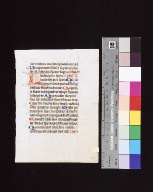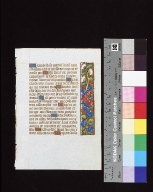|
REFINE
Browse All : manuscript (documents) and still image by Catholic Church of Netherlands
1-3 of 3
Title
Horae Beatae Mariae Virginis: fragment
Creator
Catholic Church
Summary
[Ms. This manuscript leaf is part of a collection of medieval manuscript leaves selected to illustrate the art of the manuscript during the period of its greatest development and influence. They have been taken from books written in various European scriptoria by Benedictine, Franciscan, Carthusian, Dominican, and other orders of monks. Many are enriched with handsome borders, initial letters, and line-endings rendered in color. Twenty-five are illuminated with burnished gold or silver. The texts include the Bible, various church service books, the writings of the Church fathers, and some of the Classics., In bold angular gothic script, In general, the Books of Hours produced for the devout layman in the Netherlands at the end of the 15th century were written in Dutch. This particular example, however, is in Latin. The heavy, angular, and closely spaced vertical strokes, with very short ascenders and descenders, give a much darker tone to the page than to similar scripts in such northern countries as Germany and England. This book hand resembles very closely the types known as lettre de forme which were used by certain anonymous contemporary printers in the Netherlands between 1470 and 1500 A.D. This vellum leaf was created in the Netherlands.]
Title
Horae Beatae Mariae Virginis: fragment
Creator
Catholic Church
Summary
[Ms. This manuscript leaf is part of a collection of medieval manuscript leaves selected to illustrate the art of the manuscript during the period of its greatest development and influence. They have been taken from books written in various European scriptoria by Benedictine, Franciscan, Carthusian, Dominican, and other orders of monks. Many are enriched with handsome borders, initial letters, and line-endings rendered in color. Twenty-five are illuminated with burnished gold or silver. The texts include the Bible, various church service books, the writings of the Church fathers, and some of the Classics., In angular gothic script, In assigning this leaf from a Book of Hours to the Netherlands it must be remembered that some sections of that country were once part of France, while others belonged to what is now Germany. In this leaf French characteristics predominate, but in no other country did the study of nature have a more direct influence on miniatures and ornamentations that in the Netherlands. Carnations, pansies, columbines, and many other flowers were faultlessly and realistically drawn. A few decades later, at the turn of the century, cast shadows as well as snails, butterflies, and birds were added, with the result that the borders became a distraction to the reader. This vellum leaf was created in the Netherlands.]
Title
Horae Beatae Mariae Virginis: fragment
Creator
Catholic Church
Summary
[Ms. This manuscript leaf is part of a collection of medieval manuscript leaves selected to illustrate the art of the manuscript during the period of its greatest development and influence. They have been taken from books written in various European scriptoria by Benedictine, Franciscan, Carthusian, Dominican, and other orders of monks. Many are enriched with handsome borders, initial letters, and line-endings rendered in color. Twenty-five are illuminated with burnished gold or silver. The texts include the Bible, various church service books, the writings of the Church fathers, and some of the Classics., In script, In the 15th century Books of Hours were as much in demand in the Netherlands as they were in France and England. In many of these books it is difficult to distinguish the Dutch Hours from those of Northern France or the Rhineland. In the middle of the century this whole area was interested in naturalism and made its illustrations so vivid that sometimes they approached those of our seed catalogues. It is not difficult to recognize carnations, pansies, columbines, and strawberries. The style later became even more realistic when the naturalistic flowers were painted with cast shadows. When such flowery decorations are found on a rather heavy piece of vellum,entangled with the swirling acanthus leaf and accompanied by a heavy lettre de forme script, one can be fairly safe in assigning the leaf to the province of Brabant. It was a difficult technical achievement at this time to apply the gouache colors to gold leaf so that they would adhere without flaking. This vellum leaf was created in the Netherlands.]
1-3 of 3
|


